“In politics I am growing indifferent – I would like it, if I could now return to my planting and books at home.”
– Ulysses S. Grant, former president of the U.S.A.
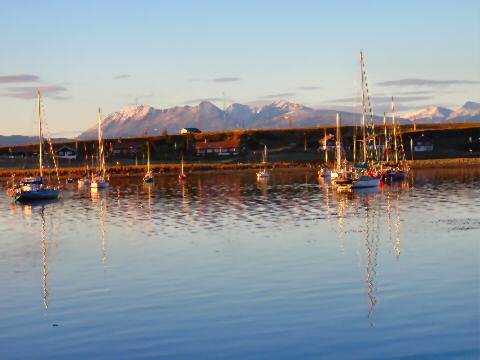 Ushuaia, Tierra del Fuego –
Ushuaia, Tierra del Fuego – I cannot decide if the right word is incurious, indifferent, or perhaps even disinterested. But it is a word somewhere in that category that describes this place for me. Not my feelings about it, though I could, perhaps develop something quite similar – it’s more the general, pervasive attitude I’ve found. Folks are friendly enough, in the “hi, how ya doin’?” sort of way, but beyond that, there’s a blankness, perhaps even a bleakness… resigned… maybe that’s a good word, I even used it yesterday in expressing how I felt about the whole tourism thing here. It shows up in the tour guides, who, for the most part, could be following as well as leading, they’re simply accompanying… our young guide on yesterday’s visit to the
pinguinera, which I’ll get to shortly, announced to us as we were getting on the bus to go back, “we’re just going to drive back via the same route, so I won’t be saying anything about it.” The guy sitting next to me grumbled, “She didn’t say anything on the way out, what’s the difference?” That wasn’t completely fair, she did say things like, “This is our first stop, you have five minutes to take pictures.” And a few times, she did actually manage a few sentences about somewhere that we were. It was the same the day before on the sailing trip – outside of the time on
Isla H, we may as well have not existed for our guide. Waiters too – they’re just all so over it all that they go through the motions. The chefs and their food. The museums and their blank faced staff. The occasional person who’s actually engaged in what they’re doing here stands out like the proverbial diamond in a coal bin.
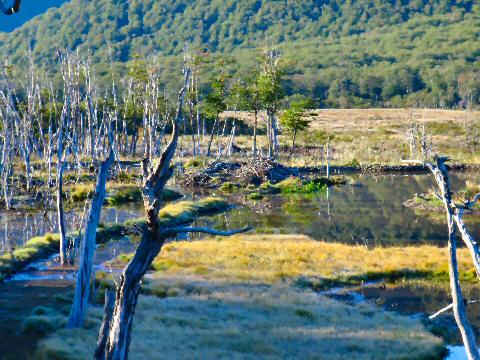
So, that all said – on to yesterday’s adventures… A van trip… oooh, my favorite, 18 of us, plus guide and driver, crammed into a van for about 3 hours out of a 6 hour tour. Remember that guy who grumbled above? He didn’t shut up the entire trip. He was like, you know, like on a like vacation from like California, you know, like and it was like exciting and like he’d read, you know, like, everything, like you know, about the area, and, like, you know, he was like, gonna like share it, like with everyone, you know. Again, I’m just going to pick out a few photos and save the rest for a Flickr album to come next week. The road trip, on the only road that leads out of Ushuaia (and you have to pass through a police checkpoint going either way, I don’t quite get what that is for – too many Chilean or Antarctic immigrants or people escaping to Chile or the South Pole? A bit of a drive up Route 3, which is the last stretch of the Pan-American Highway, then a turn-off onto a rural highway and our first stop, to see a beaver dam. Yup, there it is, a beaver dam. Lots of them around. Apparently, in the 1940s, someone got the bright idea to bring 50 beavers down from Canada and stick them in an area to start a beaver fur industry. Well, beavers being what they are, they got out of the penned up region, and spread around like wildfire – there are now more than 100,000 of them, and they’ve destroyed whole swathes of forest. So, food, fur… whatever… that seems to be the general goal around here.
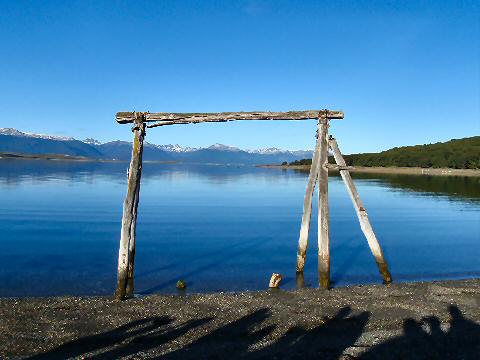
Our second stop,
Bahia Brown, or Brown Bay, presumably named after someone (who I’m sure I could look up should I not be resigned about being a tourist) – beautiful, lots of mussels apparently, though a red tide at the moment, so no eating them – and, away in the distance, which you can’t really see, Port Williams in Chile, the true southernmost outpost of civilization, though as I mentioned yesterday, at fewer than 2,000 inhabitants, the Ushuaians don’t consider it a city. Then again, that could be a whole Argentina vs. Chile thing.
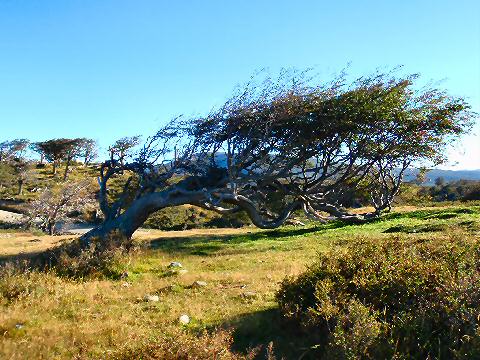
While these windswept “flag trees” are pretty much everywhere, this one is the famous one, and gets the picture postcard nod, because of its size, tangled-ness, and being over 100 years old.
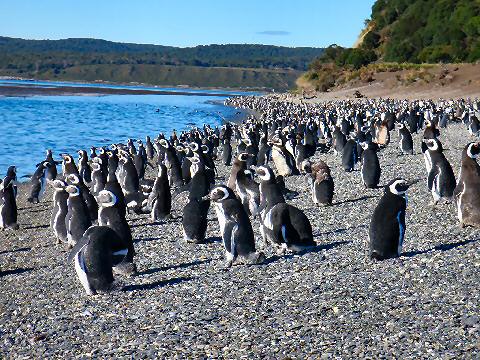
On to the
pinguinera (via pontoon boat from Estancia Harberton), and an hour spent meandering amongst the penguins. Very cool. Very cool indeed.
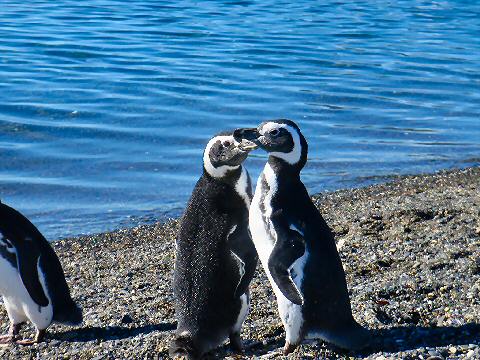
Did I mention it was very cool?
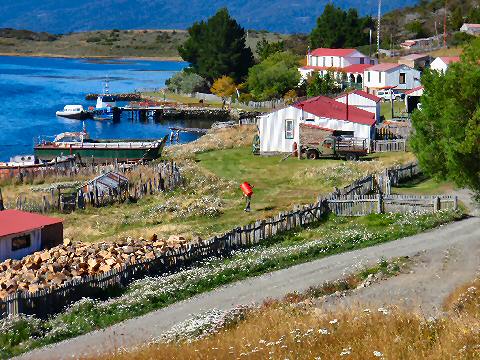
Then, back via the same pontoon boat to Estancia Harberton, one of the earliest European settlements on the island. We spent about an hour wandering the farm, having a coffee or tea. I was disappointed that their gift shop was out of their book of local rhubarb recipes – the one thing I would have been interested in buying! Then back via van an hour and a half to Ushuaia.
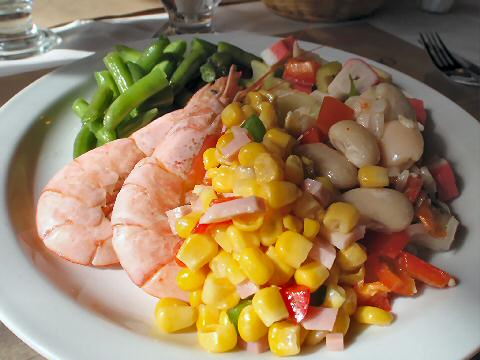
I decided my system needed a break from all that rich food I’ve been ingesting, so an all you can eat salad bar at
Arco Iris, corner of San Martín and Antartida Argentina – it’s actually an all you can eat Chinese buffet, for a mere 43 pesos, which isn’t bad – I kept it light, I certainly didn’t “all I can eat”, but this plate did me just fine.
[Closed]
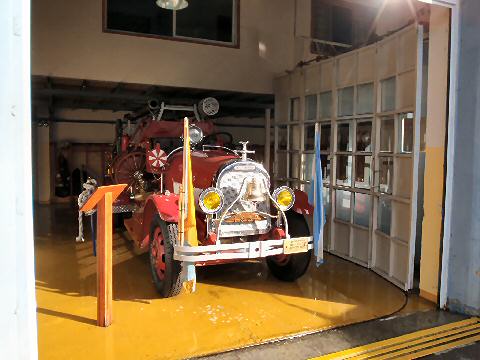
I decided to spend a little time exploring the backstreets of Ushuaia, away from the touristy strip. It’s still a bit touristy, with some of the cheaper hostels and such perched up on the hill, but it also seems to be where more of the locals live. I happened by the neighborhood fire station, where they had on display an antique engine.
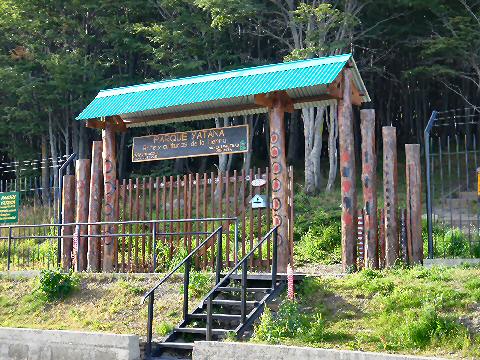
And stumbled across
Parque Yatana, a little 6 acre nature preserve that was actually a delight to visit. The woman staffing the little office at the entrance was charming, clearly passionate about the preserve, and took the time to explain how it came to exist where it is, introduced me to the artist (daughter of the woman who started the preserve) who now owns the land.
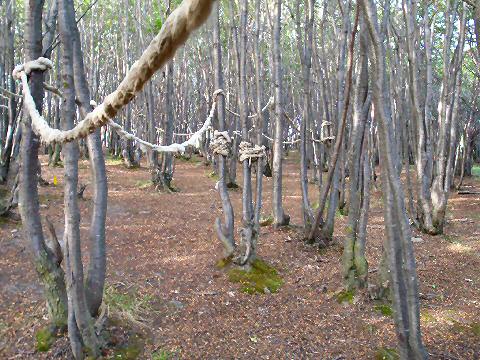
The artist, Monica Alvarado, has “installations” scattered here and there amongst the trees, and also they hold workshops for local kids who help decorate with bits of yarn and such – the name of the park, Yatana, comes from the Yámana word for weaving.
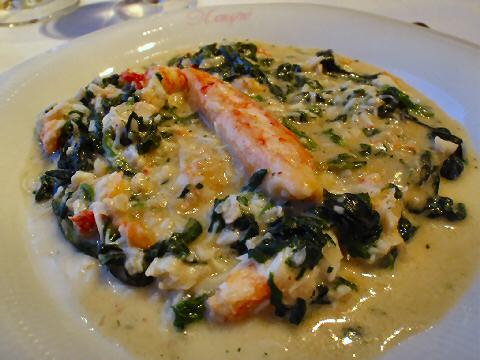
For dinner I’d arranged an evening at
Kaupé, Roca 470, touted as one of the best restaurants in all of Argentina. It’s perched way up on a hill, looking out over the city and bay – a beautiful view. The room is handsome, the staff as well. I’d been warned that “they have a bit of attitude” by various folk, including write-ups on the internet. I have to admit, I didn’t find that – they were, however, like many other restaurant staff I’ve found here, simply not all that interested in what they were doing. Their service was correct and attentive, but somehow a bit perfunctory. The chef would go into the kitchen to cook each dish (there weren’t many people dining there), and then in-between spent time sitting at a computer behind the bar. The woman who was the hostess wandered back and forth between staring at the reservation book (those four reservations for the evening never changed, amazingly) and looking at the couple of us dining there, occasionally asking if things were good. There was a lot of
“todo bien?” going on – every time someone passed by the table they asked.
And, things weren’t todo bien. They were fine. There was nothing really wrong with the food. It just wasn’t that special. This king crab and spinach “chowder” was tasty, rich, pretty much creamed spinach with crab-meat thrown in. And that’s about it. Simple, moderately elegant, and not anything to write home about (even if that’s what I’m doing). And, it cost 84 pesos. Oh, and I found four bits of crab shell over the course of eating it – more indifference on the part of the kitchen staff in preparing it.
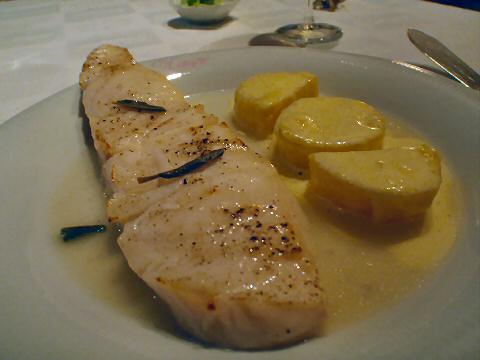
The main course, a simple fillet of Chilean sea bass once again, this time in a butter, lemon and sage sauce, with a trio of potato slices, was outrageously priced, in comparison to the other places I’ve eaten now, at 84 pesos – only outrageous because it was just this one small fillet. And, it was slightly overcooked – not badly mind you, but just enough to have that sort of squeaky, slightly chewy feel to it that says someone left it in the pan a little too long. Add to that a bottle of
Rutini Gewurztraminer priced at 107 pesos, and this was an expensive evening. But I knew that going in, right? I just expected a whole lot more from the kitchen.


















The checkpoint is there for a few reasons. As you noticed, since there is only one road out of Ushuaia it allows the police put a damper on crime and increase road safety. Quite a few times they’ve been able to nab someone with a stolen car or goods–either leaving Ushuaia or coming from Rio Grande. The checkpoints were kind of sporadic before but ever since that little girl went missing months ago and the increase in crime, they’ve turned up the heat.
Also, there is about 200 km of road between Ushuaia and Rio Grande where you may pass one car every minute or every 30 minutes. 1/3 of that winding through mountains and valleys. With no speed traps or radar it can be both fun and dangerous. So basically they want to check for proper paperwork and register the car as entering or leaving–in case someone ends up missing. During the summer, holidays, or in the middle of winter they’ll set up spot checkpoints throughout the route for drunks coming from an asado in the campo, proper tires for snow in winter, etc.
Maybe one of the local book stores has that rhubarb recipe book, I’ll keep an eye out next time I step into one.
I guess that makes sense, although they seemed to only be randomly stopping cars – not every one. Of course, I’m sure some of the folk passing through are regulars who they simply know and wave on.
I looked for the book in a couple of stores – though, it was a cookbook from Estancia Harberton, so they may not distribute it elsewhere. The kid behind the counter just couldn’t find any copies and no one else was available to tell him where they might be – so it may not have really been that they were out of them, just didn’t locate them while I was there.
This just looks like an amazingly cool and interesting place, Dan, from a physical and natural history point of view. Sounds like the locals don’t quite have the tourism thing down yet. Love those penguins! Did you happen to spot Morgan Freeman?
It really was a great little visit, and I was actually sorry to leave so soon. I can’t say I was thrilled with the prices, especially for the food, and the quality, for the most part, was far less than what I’d expected, or hoped for at least. Then again, I really didn’t explore restaurants outside of the central area of town, and the next time I go down I’d really like to do so. Probably more local cuisine and more reasonable prices, as I’m sure that the locals don’t generally pay those kind of prices.
Morgan F and his penguins were in Antarctica, not Tierra del Fuego… long way away!
Dan, I think you really nailed the Ushuaia scene and experience. I was there for two visits of about 9 days each for nordic skiing in month of July a couple of years ago in the dead of their winter. I had a few great meals at Kaupe but the price points compared to BA were very high.
My highpoint of the seafood experience was a small small cafe downtown where the centolla was amazing and my plate was heaped with crab meat. So good. Some other places it had the distinct frozen taste to it and I think at this time of year all of it was from frozen stock. The Patagonia toothfish or sea bass was hit or miss too, but a couple of times, it was outstanding and again at this now forgotten name of a restaurant.
The town itself had a little feel of a time forgotten place where the mainstream of life had bypassed it by. Winter with the melt and snow and also fresh snow seemed to reinforce this. The skiing was great and overall I very much enjoyed my time there.
The hotel I stayed in was great overlooking the bay and while not huge, of great value of around 50 pesos a night.
Regards,
Jim in Minnesota
http://www.maplelag.com
The cost of living here is one of the highest in the country and I believe TDF is ranked 3rd for highest median salaries. (Santa Cruz and Chubut are 1 and 2)
To give you some perspective of prices on the other side of the island for, at least, decent restaurants. Appetizers range from $25 for rabas to $35-$40 for copa de whatever seafood or lamb stew. Main course meats and seafood from $40 to $65. If that’s what the menu looked like at Bodegón Fueguino then that’s your typical TDF restaurant with at least decent fare.
That’s about the prices they were charging for things. And I liked that, although there were plenty of tourists in the room, there were also clearly plenty of locals/regulars. The place just felt more “local” or “authentic”, however one might define those.
[…] pretty much the first white person, to head into Tierra del Fuego – and was the founder of Estancia Harberton, which I visited on my Ushuaia trip last year. Also buried in the same plot are his son, Estaban […]
[…] El Viejo Bar, along with a selection of local beers, or even grabbing an all you can eat lunch at Arco Iris along San Martín when we just needed a salad […]